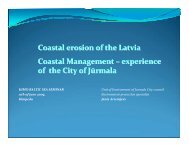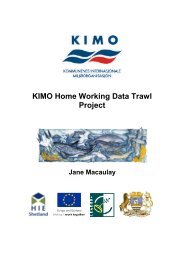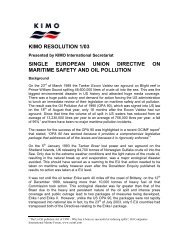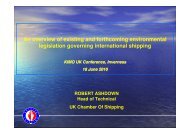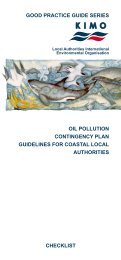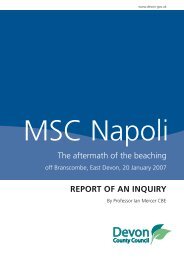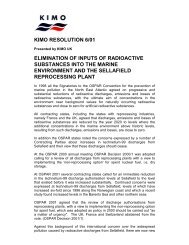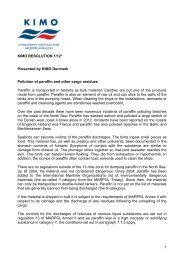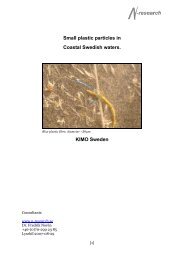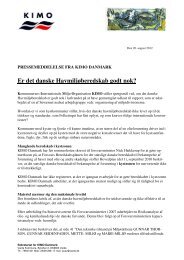Download the full microplastics research proposal here. - KIMO
Download the full microplastics research proposal here. - KIMO
Download the full microplastics research proposal here. - KIMO
You also want an ePaper? Increase the reach of your titles
YUMPU automatically turns print PDFs into web optimized ePapers that Google loves.
additional burden of contaminants in animal tissues. The outcomes of <strong>the</strong>se experiments will<br />
<strong>the</strong>n be modelled to give a risk assessment of <strong>the</strong> types, quantities and condition of plastic<br />
debris that would be required to cause detrimental effects on natural populations.<br />
A<br />
B<br />
C<br />
Transmission (%)<br />
50 µm<br />
fragment from shore<br />
nylon<br />
4000 2400 1400 650<br />
Wave number cm -1<br />
D<br />
Fibers 50ml -1 sediment<br />
8<br />
6<br />
4<br />
2<br />
0<br />
Sandy<br />
*<br />
Estuarine<br />
Subtidal<br />
E<br />
Fibers m 3 seawater<br />
0.08<br />
0.06<br />
0.04<br />
0.02<br />
0<br />
CPR 2<br />
*<br />
1960's<br />
1970's<br />
1980's<br />
1990's<br />
25<br />
20<br />
15<br />
10<br />
5<br />
0<br />
CPR 1<br />
Production of syn<strong>the</strong>tic<br />
fibers 10 3 tons yr -1<br />
Fig. 2) (A) Fragment of microscopic plastic<br />
from shoreline. (B) Sampling locations in<br />
North-East Atlantic, showing Routes<br />
sampled by Continuous Plankton Recorder<br />
(CPR 1 and 2) since 1960 and used to<br />
assess <strong>the</strong> abundance of <strong>microplastics</strong> in <strong>the</strong><br />
water column (Fig. 1E). Shores w<strong>here</strong><br />
similar fragments were found (●) and<br />
location of sites near Plymouth (□) used to<br />
compare <strong>the</strong> abundance of microscopic<br />
plastic among habitats (Fig. 1D). (C)<br />
Example showing how FT-IR spectroscopy<br />
was used to identify fragments from <strong>the</strong><br />
environment. Here an unknown fragment is<br />
identified as nylon. (D) T<strong>here</strong> were<br />
significant differences in abundance of<br />
<strong>microplastics</strong> between sandy beaches and<br />
subtidal habitats (ANOVA, F 2,3 = 13.26, * =<br />
P < 0.05), but abundance was consistent<br />
among sites within habitat type. (E)<br />
Accumulation of microscopic plastic in CPR<br />
samples revealed a significant increase over<br />
time when comparing <strong>the</strong> 1960’s and 1970’s<br />
to <strong>the</strong> 1980’s and 1990’s (ANOVA F 3,3 =<br />
14.42, * = P < 0.05). Approximate figures for<br />
global production of syn<strong>the</strong>tic fibres overlain<br />
for comparison. Microplastics were also less<br />
abundant along <strong>the</strong> oceanic route CPR 2<br />
than CPR 1 (F 1, 24 = 5.18, P < 0.5).<br />
Reproduced with permission from Thompson<br />
et al. (2004), Lost at sea w<strong>here</strong> does all <strong>the</strong><br />
plastic go? Science, 304, 838.<br />
The proposed <strong>research</strong> will require a three-year position for an experienced postdoctoral<br />
<strong>research</strong>er toge<strong>the</strong>r with technical support for <strong>the</strong> numerous analyses and invertebrate trials.<br />
The University of Plymouth has all of <strong>the</strong> facilities to undertake <strong>the</strong> work, including a state of <strong>the</strong><br />
art ISO 900-acredited radio-chemical facility. Costs for <strong>research</strong> staff, consumables and<br />
overheads are around £150,000 per year for three years (total £450,000). We are applying to<br />
<strong>the</strong> Natural Environment Research Council (NERC) for funding in <strong>the</strong> form of a partnership<br />
grant (deadline 1/12/08). These grants require a 25% external contribution with NERC covering<br />
<strong>the</strong> remaining 75% of <strong>the</strong> costs. We are <strong>the</strong>refore seeking partners to contribute some or all of<br />
<strong>the</strong> £112,500 external funding (£37,500 per year for three years).<br />
Our work to date has attracted considerable interest from <strong>the</strong> general public, <strong>the</strong> media (New<br />
York Times, Washington Post, La Monde, El Pais, Guardian, BBC), government (Defra and<br />
Cefas in <strong>the</strong> UK and NOAA in <strong>the</strong> US) and non-government organisations including OSPAR,<br />
<strong>KIMO</strong> and Marine Conservation Society. The proposed work represents a major advancement<br />
in our knowledge about <strong>the</strong> effects of debris in <strong>the</strong> environment. <strong>KIMO</strong>, an international<br />
association of local authorities committed to reducing marine litter, have given <strong>full</strong> support to <strong>the</strong><br />
<strong>proposal</strong> and agreed to facilitate discussions with potential project partners/funders. <strong>KIMO</strong> will<br />
subsequently act as an advisor on <strong>the</strong> steering committee and promote <strong>the</strong> project results to<br />
policy makers through <strong>the</strong>ir observer status at <strong>the</strong> OSPAR Commission. It may also be possible<br />
for o<strong>the</strong>r funders to join <strong>the</strong> steering committee. Fur<strong>the</strong>r information on how to participate with<br />
<strong>KIMO</strong> as a project partner/funder can be obtained from John Mouat<br />
(john.mouat@kimo.shetland.org) or Dr Richard Thompson (rcthompson@plymouth.ac.uk).



